February 28, 2023 feature
This article has been reviewed according to Science X's editorial process and policies. Editors have highlighted the following attributes while ensuring the content's credibility:
fact-checked
peer-reviewed publication
trusted source
proofread
Observing phononic skyrmions based on the hybrid spin of elastic waves
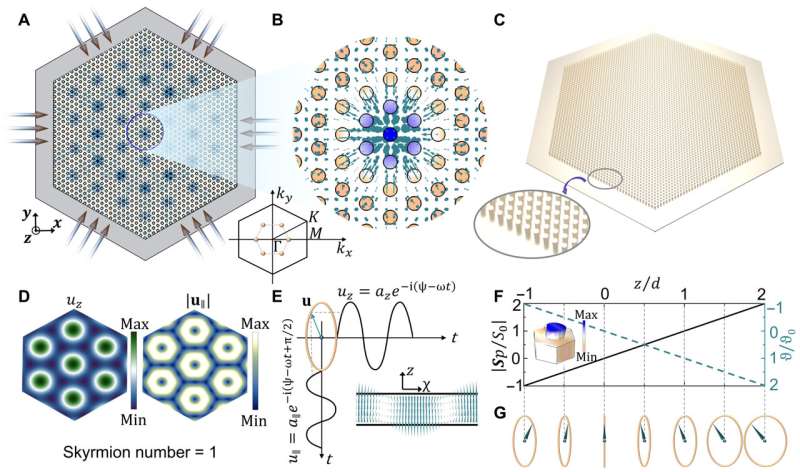
Skyrmions are extremely small with diameters in the nanoscale, and they behave as particles suited for information storage and logic technologies. In 1961, Tony Skyrme formulated a manifestation of the first topological defect to model a particle and coined it as skyrmions. Such particles with topologically stable configurations can launch a promising route toward establishing high-density magnetic and phononic (a discrete unit of quantum vibrational mechanical energy) information processing routes.
In a new report published in Science Advances, Liyun Cao and a team of researchers at the University of Lorraine CNRS, France, experimentally developed phononic skyrmions as new topological structures by using the three-dimensional (3D) hybrid spin of elastic waves. The researchers observed the frequency-independent spin configurations and their progression toward the formation of ultra-broadband phononic skyrmions that could be produced on any solid structure.
The new research work opens a vibrant horizon to regulate elastic waves and structures based on spin configuration, thus offering alternative phononic technologies well suited for information processing, biomedical testing and wave engineering applications.
The physics of skyrmions
Skyrmions can be defined as a topologically stable three-component vector-field, as demonstrated in condensed matter systems and helimagnetic materials. Such phenomena form promising avenues for information storage and transfer. Physicists are exploring nontrivial skyrmion configurations for elastic phonons known as "elastic waves in solids" due to their sophisticated polarization states. When compared with photonic systems, elastic phonons provide an excellent platform to carry and process information due to their unique features, which include a scalability towards forming integrated devices and an anti-jamming capacity with extremely low losses.
Phonon physics has led to advanced technologies in high signal-to-noise information processing, alongside intense wave-matter interactions suited for quantum networks. In this new work, Cao and colleagues have developed a nontrivial topological structure of ultrabroadband phononic skyrmion-based on the 3D hybrid spin of elastic waves. The team formed the phononic and photonic skyrmions via different spin textures.
Forming phononic skyrmions via intrinsic hybrid spins
Researchers can establish elastic spin by hybridizing transverse and longitudinal waves in an elastic interface. This hybrid spin can be formed on a free surface that supports Lamb waves and Rayleigh waves and also exist in an infinite isotropic bulk space without interfaces based on two-wave interference.
The researchers created a compact structure by building the phononic skyrmion system within a thin-plate model that supported the hybrid spin of the Lamb wave that arose from the hybridization between longitudinal and transverse waves in the upper and lower plate interfaces of the experimental setup. In order to create the phononic skyrmions in the lab, the team designed a hexagonal metaplate with pillared resonators and excited three pairs of counter-propagating plane Lamb waves with hybrid spins during the experiment.
-
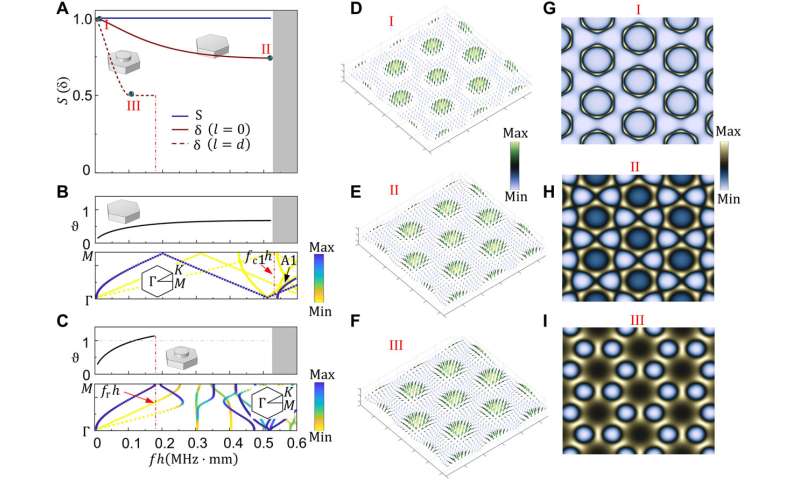
Ultra-broadband and tunable characteristics of phononic skyrmions. (A) Skyrmion number S (solid blue line) for an elastic plate as a function of the frequency-thickness product fh. The solid and dotted magenta lines indicate the skyrmion number density contrast δ of the wavefields in the top plane of elastic structures without and with pillared resonators, respectively. The two illustrations are unit cell models with sixfold rotational symmetry, a plate with thickness of h = 1 mm, and a pillar resonator with height of l = d on the plate top. (B and C) Top subfigures are the polarization ϑ of the wavefields in the top plane of elastic structures without and with pillared resonators. The bottom subfigures are band-like dispersions in the ΓM direction. The lattice constant of the unit cell model is a0 = 4h. (D to F) Vector fields (color bar for the amplitude of its axial field). (G to I) Theoretical skyrmion number density profile obtained from the theoretical calculations. The unit cell models for profiles in (G) to (I) are consistent with those indicted by solid and dotted magenta lines in (A). Credit: Science Advances (2023). DOI: 10.1126/sciadv.adf3652 -
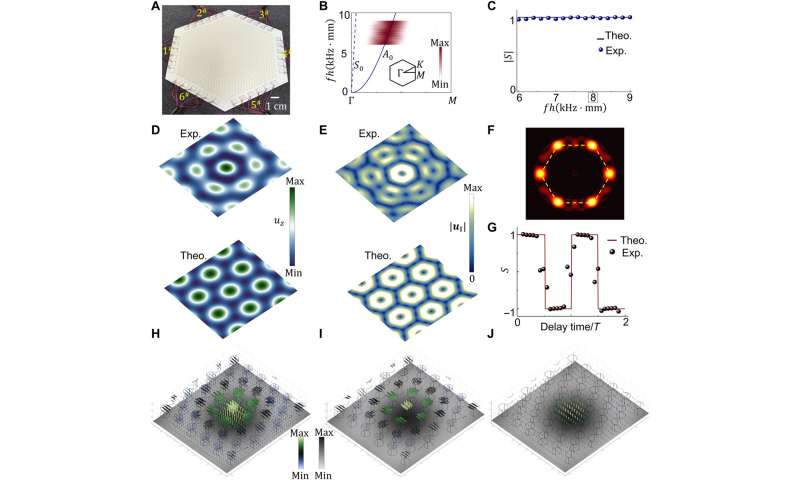
Observation of phononic skyrmions. (A) Experimental metaplate. (B) Experimental and simulated band-like dispersions (colors and lines, respectively). (C) Experimental and theoretical skyrmion number in the whole measure frequency range. (D and E) Axial and transverse displacement fields in 8 kHz. (F) 2D fast Fourier transform of the measured axial displacement field. (G) Experimental and theoretical skyrmion number as a function of time delay for two cycles of the skyrmion lattice in 8 kHz. T = 0.125 ms is one cycle. (H) Snapshot of movie S3 for the experimental Néel-type skyrmion vector field in the 3D space. The image beneath the vectors shows the vertical component of the wavefield. (I) Vector fields at the 2D top plane of pillared resonators (Néel-type–like skyrmion). (J) Vector fields at the bottom plane of the hosting plate (bubble-type skyrmion). Credit: Science Advances (2023). DOI: 10.1126/sciadv.adf3652
Tunable characteristics of the elastic, robust phononic skyrmions
Cao and colleagues observed the ultra-broadband topological robustness feature of the phononic skyrmions caused by the frequency-independent 3D hybrid spin texture of the elastic waves. They also facilitated fluid-solid coupling to develop a non-trivial acoustic skyrmion field in fluids. The team then used a 3D printer to print a hexagonal-symmetry metaplate with pillared resonators and noted good agreement between the experimental and simulated dispersions. They then confirmed broadband characteristics of the phononic skyrmions and observed transitions of different types of skyrmions in the geometric space, which showed the contribution of pillared resonators towards constructing 3D skyrmion configurations.
The work additionally established the robustness of the nontrivial topological phononic skyrmion lattices. For instance, when the team introduced defects to the setup, they did not affect the skyrmion lattice architecture, proving that phononic skyrmions were robust against the defects, indicating stability of the skyrmion field.
-
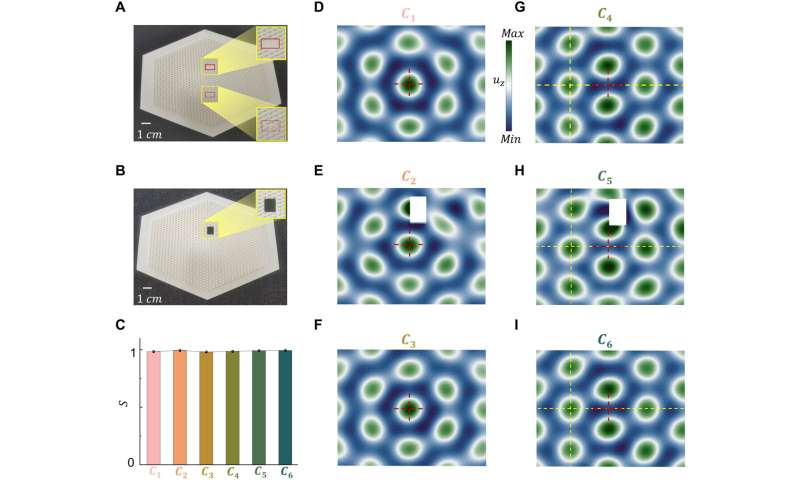
Robustness of phononic skyrmions. (A) Structure with the defects of removing (see the solid line box) and disorderly arranging (see the dashed line box) pillars, i.e., structure I. (B) Structure with a rectangular hole, i.e., structure II. (C) Experimental skyrmion numbers for cases from C1 to C6. (D to F) Experimental axial wavefields at the center of structure I, structure II, and reference structure without defects, respectively, marked as cases from C1 to C3. (G to I) Experimental wavefields for cases from C1 to C3 are shifted leftward by λ, respectively, marked as cases from C4 to C6. The dotted red line intersection is the midpoint of the central lattice before it shifts. The distance between the dotted yellow line intersection and the red one is λ. Credit: Science Advances (2023). DOI: 10.1126/sciadv.adf3652 -
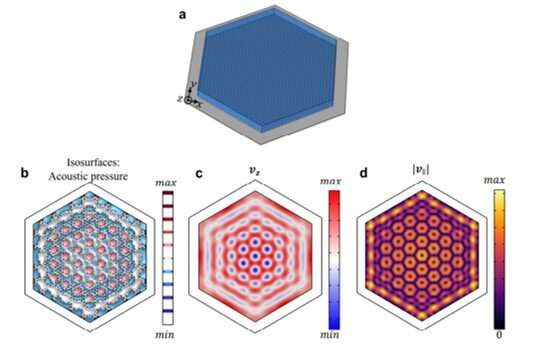
Acoustic skyrmion fields in liquids from the fluid-solid coupling. a, The typical fluid-solid coupling model with the hosting plate thickness of h = 1mm. The pillar radius, pillar height, and water layer thickness are h, 3h, and 10h, respectively. The lattice constant of the single-unit model is a0 = 4h. The excitation frequency is 8 kHz. The origin of the coordinate axis is located on the top surface of the hosting plate. (b, c, and d,) The simulated sound pressure isosurface, the axial velocity field, and the transverse velocity field in the x-y plane (z = 5h). Note that the fluid-solid coupling leads to the nontrivial acoustic skyrmion field in liquids, which can have the same ultra-broadband and tunable characteristics as the phononic skyrmion field. Credit: Science Advances (2023). DOI: 10.1126/sciadv.adf3652
Outlook
In this way, Liyun Cao and colleagues described and observed the formation of ultra-broadband phononic skyrmions in theory and in practice based on the 3D hybrid spin of elastic waves. The phononic skyrmions were robust against local defects of disorder, and demonstrated ultra-bandwidth, well-suited for high-speed topological phononic information processing technologies. The 3D hybrid spin states can open new pathways to regulate phonons and explore new topological orders.
The work presents a range of possibilities to create new topological phononic materials across the macro-to-microscale. The scientists showed the possibility of creating tunable, phononic skyrmions in any elastic wave system, including solid-solid, solid-gas or solid-liquid interfaces. Of note, the fluid-solid coupling can pave the way toward skyrmion lattice matter systems in fluids, well suited to observe cell dynamics in microfluidics instruments and for biomedical testing. These outcomes will facilitate advanced integrated information platforms to connect interdisciplinary physics across electronics, phononics/photonics and the life sciences.
More information: Liyun Cao et al, Observation of phononic skyrmions based on hybrid spin of elastic waves, Science Advances (2023). DOI: 10.1126/sciadv.adf3652
Shujie Yang et al, Harmonic acoustics for dynamic and selective particle manipulation, Nature Materials (2022). DOI: 10.1038/s41563-022-01210-8
Journal information: Nature Materials , Science Advances
© 2023 Science X Network





















